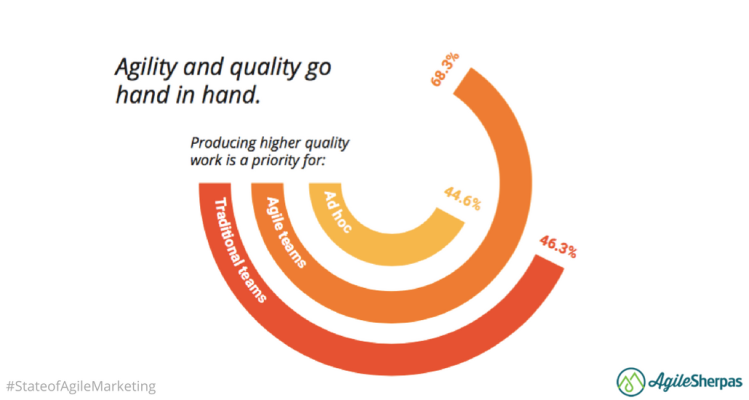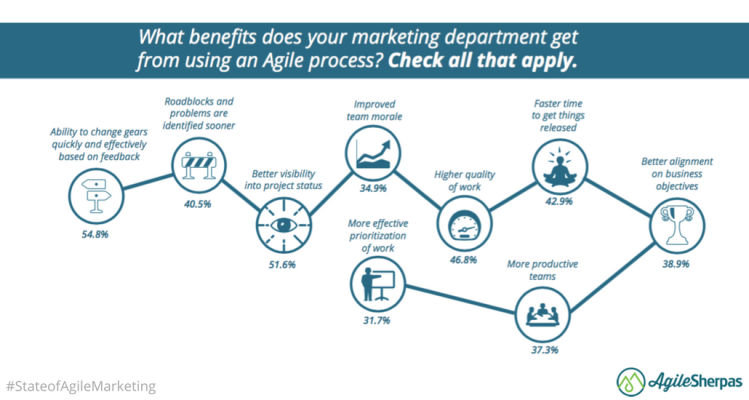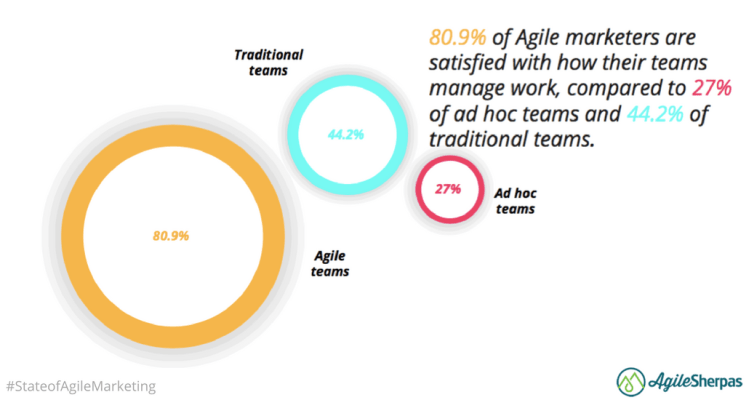If you sit a group of marketers down and ask them to talk about their most painful professional moments, chances are you’ll hear variations on several themes:
?We never know if we’re focusing on the right things. There’s so much to do I feel like we’re just running from one campaign to the next.?
?I know we could be doing better work, but who has time to worry about that? I?ve just got to get stuff out the door.?
?I can barely keep up with what my own team is doing. I know we should be working more closely with sales and the teams serving other business units, but I can’t bring myself to schedule another meeting to figure out how.?
Marketers have access to more data, more technology, and more people than ever before, but most of us would trade it all for a little more time. The pace of change in our industry has been (and continues to be) staggering, but so far our processes haven’t managed to keep up.
The future, however, looks brighter.
More and more marketers are changing the way they get things done. They’re adopting practices from the world of software development, the world’s first purely digital profession and the one that spawned Agile methodologies like Scrum, Kanban, and Lean.*
The reasons behind these transformations are as varied as the organizations taking them on, but they fall into three broad categories:
- Doing the right work based on organizational goals and audience preferences.
- Picking the right time to tackle those projects, allowing for more real-time, responsive marketing.
- Creating higher quality work, which is the only way to make an impact in an increasingly noisy digital world.
Agile Helps Prioritize the Right Work
In the State of Agile Marketing Report we recently asked hundreds of marketing professionals about their process. Those who have already made the switch to Agile told us that a better understanding of priorities and alignment was high on their list of reasons to change.
Forty-eight percent were looking for an ?enhanced ability to manage changing priorities,? which makes sense given the constantly shifting landscape of marketing.
One audience segment might prove less valuable than we thought, or a new channel might emerge that we need to jump on right away. Marketers need a process that lets them pivot efficiently, whether that’s to move away from a failure or to take advantage of an emerging opportunity.
Agile marketing makes both these strategies possible and less painful.
As Scott Brinker puts it in Hacking Marketing, ‘rebalancing happens. If we don’t rebalance intentionally, it happens unintentionally. We then discover the ripple effects as we go along. Ironically, the consequences of those unexpected ripple effects can turn into new, urgent issues themselves.?
Over time this cycle ?degrades [marketing’s] ability to execute well-thought-out plans in an efficient and coordinated fashion.?

Another 46 percent of the respondents went Agile to gain better alignment with other teams and business objectives. Again, this makes sense because marketing doesn’t happen in a vacuum (however much we might wish it could sometimes).
Since Agile teams become more responsive and adaptive, they can stay in sync with strategic priorities and other teams? goals more easily.
But it’s not just about responding to external demands. Agile tools like Sprints and WIP (Work in Progress) limits allow marketers to stay true to their own top priorities (i.e. they let us actually start telling people ?No? when they ask for something ASAP) while still letting us embrace change in the short term.
For more on these agile topics, be sure to check our upcoming webinar.
Responsive, Real-Time & Agile Marketing
Timing is everything in the digital world. Marketers who can meaningfully connect with their audiences around the latest meme, a breaking news event, or this week’s adorable baby animal video can garner a huge advantage.
But none of that’s possible if we’re working flat out just to hit the next looming deadline.
Agile, fortunately, improves both the speed and productivity of marketing teams.
In the AgileSherpas State of Agile Marketing Report, we found that 55 percent of Agile marketing teams can change gears quickly and effectively based on incoming feedback, while another 43 percent can release their work faster.
This combination of responsiveness and speed means Agile teams can start delivering relevant marketing messages in near real time.
Agile marketing teams meet daily for standup meetings and conduct planning sessions every couple of weeks. Consider how much faster they can metabolize incoming data than a marketing team that plans once a year.
It’s not hard to see why Agile teams are pulling ahead of their competitors, and why the future belongs to teams who can embrace the Agile mindset.
Agile Delivers Higher Quality Marketing
This last benefit is one that non-Agile teams may not consider, but it could be argued that quality is even more important than prioritization and speed.
Our audiences are exposed to thousands of brand messages every day, switching screens over a dozen times in an hour. The only way to stand out in that kind of environment is to follow the advice of the brilliant Steve Martin: ?Be so good they can’t ignore you.?
And who will produce work that good? The marketer being pulled in ten different directions and asked to split her time among five ?crucial? projects, or the one who can devote his full attention and creativity to a single brilliant project?
The latter is far more likely to be part of an Agile marketing team, where he can gain focus and reduce the incidence of multitasking.
It’s no surprise, then, that 47 percent of them report a higher quality of work following the switch to an Agile way of working.
In fact, producing higher quality work was a priority for 68 percent of Agile teams, while only 46 percent of traditional marketers saw quality as a top priority.
It seems pretty clear which teams have a shot at creating marketing that’s so good it can’t be ignored, and which ones will blend into the background of digital noise.
Why Isn’t Everybody Going Agile?
If Agile lets marketers do the right work at the right time at a higher level of quality, you might wonder why anybody would choose to work another way. Our research revealed two major causes: lack of education and complacency.
Forty percent of the marketers we surveyed told us that a ‘lack of training or knowledge about Agile approaches? was keeping them from taking the next step on their Agile journey.
The Aprimo webinar series on agility hopes to help bridge that gap, as do training organizations like AgileSherpas. But it’s ultimately up to marketing leadership to embrace the need for education and encourage their teams to explore new options.
Then we have the 26 percent who believe that their ?current process is working well enough.?
Frankly, this number scares me. It may seem easier to settle for the status quo if it’s not too painful right now, but these ?good enough? approaches won’t hold up much longer. Change is coming, and we can proactively prepare or struggle to react.
What’s more, Agile transformations don’t happen overnight. They take time to bear fruit, with most teams needing six months to start seeing real results (large teams of 50 or more may take even longer).
That means delays in changing your process aren’t just impacting the work you’re doing now, they’re holding back your success for months or years into the future.

Finally, the longer you delay, the more likely it is that a competitor will go Agile and jump so far ahead that you’ll be playing catch up for the foreseeable future. Sixty-one percent of the traditional marketing teams we surveyed had plans to start down the Agile path within a year.
Will you join them, or will you be left behind?
* These methodologies have their roots in earlier industries, such as manufacturing, but software development was the first time they were applied to knowledge work to create the Agile approaches used in Agile marketing.



